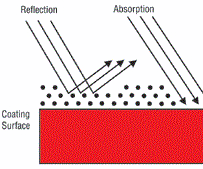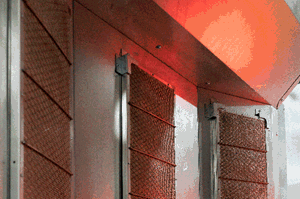Understanding Infrared Curing
Infrared cure is gaining increased attention from coaters as a result of shorter cure cycles and the possibility of smaller floor space requirements when compared to convection oven curing.
Theory
Infrared energy is a form of radiation, which falls between visible light and microwaves in the electromagnetic spectrum. (See Figure 1) Like other forms of electromagnetic energy, IR travels in waves and there is a known relationship between the wavelength, frequency and energy level. That is, the energy (temperature) increases as the wavelength decreases (See the directional arrows in the figure).
Unlike convection, which first heats air to transmit energy to the part, IR energy may be absorbed directly by the coating. It may also be reflected or transmitted to the substrate. (See Figure 2) When the equipment is properly matched with the application either absorption (to heat the powder) or transmission (to heat the part) may become the primary method used to achieve cure. Because the energy is radiant (in the form of radiation), IR cure is known to have limitations based on line of sight. That is, the energy only travels in a straight line, to be absorbed by sections of the part facing the source, much like a flashlight illuminating an area of the part.
Since the thermal conductivity of metals is excellent, some energy may be selectively transmitted to the substrate resulting in cure of hidden areas via a conduction mechanism. This allows cure to be achieved on the inside of a steel tube, for example. Also, in some cases IR may provide some degree of convection heating, which also helps to achieve non line-of-sight cure. IR systems are usually described as high, medium or low intensity. This refers to the energy level of the source.
- High energy (short wavelength) IR is characterized by bright visible light which is also emitted. Most of the energy is transmitted through the coating to be absorbed by the substrate. This type of cure is therefore best suited for complex part shapes (non line-of-sight heating) where it is used to heat the substrate. The fastest heat up rate is possible with high energy IR.
- Medium energy (medium wavelength) IR is the most widely used for curing because the energy is absorbed directly by the coating. This type of oven works best with simple or symmetrical parts and frequently the parts are rotated for uniform exposure. Also, the oven configuration must match the shape of the part, e.g. ceiling and floor mounted emitters assist in illuminating the top and bottom of cylindrical parts.
- Low energy (long wavelength) IR is not effective for cure. Much of the energy generated is lost to inefficient convection heating. The fraction of IR energy which does reach the coating is absorbed at the surface, resulting in possible “skin formation” or other defects.
Control
Most IR sources emit energy over a band rather than at a single wavelength or frequency. The broadness of this band, known as purity, can have a major effect on the cure since it establishes the degree of penetration. Some systems allow a limited degree of tuning for control by voltage adjustment. An optical pyrometer can be built in to show emitter surface temperature which increases with increasing voltage. More sophisticated units have feedback loops through programmable logic controllers.
Another control point is the amount of energy available at the surface of the coating. This is known as the watt density. If the watt density is too high the coating will scorch and degrade at the surface. This parameter may be adjusted by decreasing the number of emitters or by increasing the distance between the emitter and the part.
Equipment
Infrared radiation can be generated from both electric and gas sources. In the case of electric infrared, tungsten filament generally provides short wavelength (@ 3000-4000F surface temperature) and nichrome filament provides medium wavelength (@ 1800- 2000F). The filaments are usually encased in a quartz tube. Long wavelength generators operate at a surface temperature of 1000-1200F and only 40-50% of the electrical energy is converted to IR, with the remainder resulting in convection heating. Lamps and filaments form the IR emitter, which is usually accompanied by some sort of reflector to focus the energy. The walls of the oven may also serve as a secondary reflector. All require maintenance. Short wavelength emitters have a life of approximately 5,000 hours at normal voltage settings, with lower settings resulting in longer life. Reflectors may be constructed with precious metals such as gold to achieve optimum reflection and or purity of the IR emissions. An accumulation of dust or dirt will interfere with the performance of the system.
Gas IR ovens use a flame to heat a ceramic emitter which in turn generates the IR radiation. “Flameless systems” which catalytically oxidize the fuel are also available. Gas IR is available in medium to long wavelength only and the emission spectrum is usually broader than electric IR, e.g. lower purity. Gas IR is frequently paired with a gas convection oven to provide faster heat up rates than convection alone could achieve.
Powder Coatings for IR Cure
Powders used in combination IR-Convection systems or low to medium intensity IR-only systems are the same as powders selected for convection-only cure. That is, these systems generally offer comparable cure times, in the 8-20 minute ranges. Fast curing powders, e.g. 400F for 5 minutes or less, are the best candidates for high or high to medium intensity IR systems. The actual dwell time in front of the emitters in this case is typically anywhere from 30-90 seconds.
Because powders generally respond well to fast heat up rates, IR can present some advantages with respect to appearance. High gloss coatings for example may be even higher in gloss. Unfortunately, low gloss systems may respond the same way, making gloss prediction a little tricky. Trial runs or on-line evaluation of lab samples can overcome this uncertainty. With rapid cure there is also limited opportunity for flow, therefore low viscosity in the melt is an important characteristic to overcome orange peel.
Color of the coating can also play a comparatively small role in the cure process. Black coatings tend to absorb radiant energy more readily than other colors while whites reflect. This can mean that oven adjustments may be required to overcome these tendencies.
Application Advantages and Disadvantages
Two-dimensional parts such as steel blanks and light switch plates, as well as symmetrical three-dimensional parts such as oil filters, pen barrels and tubing represent some of the most common end uses for IR. In the latter cases the parts may be rotated to achieve uniform radiant energy distribution. Other applications include heavy castings which would require long heat up times or very high temperatures in a convection oven. Heat sensitive substrates such as plastics and composites also receive potential benefits from IR cure since the coating alone can be heated and the oven dwell time can be short enough to prevent substrate damage.
IR-only systems do not require high airflows common in convection ovens. As a result dust and dirt contamination can be minimized. The lack of combustion byproducts in electric IR makes this a cleaner process as well.
Despite the potential advantages, many problems must also be investigated when considering IR cure. The first is that complex part shapes can be difficult to cure with IR-only ovens. Radiation travels in straight lines and does not turn corners without the aid of reflection. Hidden internal surfaces may not cure without the assistance of conduction or convection.
In addition to part shape, the composition and condition of the substrate can also represent a source of variation. Individual metals absorb IR energy differently. This property is known as emissivity. Gold, which has a very low emissivity, for example, is frequently used as a reflector because of its low absorption. While common substrates such as iron, steel and aluminum have emissivities in the same general range, polishing can change each of these from good absorbers to reflectors.
Variation in part mass can also be a problem. Systems designed to cure powder in 60 seconds on 16-gauge steel may provide less than adequate cure on doubled mass and weld seams due to a heat sink effect. This is common on the “chime” area of oil filters, for example. Heat energy is pulled away from the thin substrate and insufficient energy remains to cure the coating.
IR ovens can be zoned to provide more energy output for the initial heat up stage and lower output for the leveling or “hold” stage. Some systems may also allow selected emitters to be turned on and off for different part types. These variable controls allow for the greatest degree of flexibility in part mix. Rapid on-off controls can help to prevent overbake during line shutdown as well as offering a quicker look at parts after line adjustments.
The most flexible systems offer a degree of control, which actually exceeds that of convection ovens. If the oven and the powder are properly matched to the part, a similar “cure window” may be available. For example, a 120-second dwell time may not cause problems for a coating designed for a 60-second cure. This is the same 100% overbake generally built into convection cured coatings. The real problem is that the absolute time of 60 seconds offers little chance to react to problems. This has led to a belief that IR is a less forgiving cure mechanism when compared to convection.
Summary
IR cure can be the right choice for many applications. Oven suppliers and coaters who know and understand all aspects of the equipment are best suited to deal with the complexities of these systems. Symmetrical parts and simple configurations, with limited to no change, offer the best chances of success. Proven powders are available for most common applications with the most important characteristic being reactivity matched to the cure system. When it comes to IR there is no substitute for testing, whether the intent is to install new equipment or to introduce a new powder or part configuration.
Related Content
Heat Up Your Maintenance Plan for Best Oven Performance
Improve efficiency and profitability with a preventive maintenance program for your industrial heating equipment.
Read MoreIHEA Announces 2023-2024 Board of Directors
The Industrial Heating Equipment Association has announced its Board of Directors and Executive Officers for the coming year.
Read More5 Maintenance Tips for Gas Catalytic IR Ovens
Basic and periodic preventive maintenance is essential for avoiding oven downtime.
Read MoreSpecialty Oven’s Hot Benefits and Other Questions Answered
Learn about the advantages of gas catalytic infrared pre-gel ovens in this article, including how they are energy efficient and can save users time and money when integrated into their existing systems.
Read MoreRead Next
Delivering Increased Benefits to Greenhouse Films
Baystar's Borstar technology is helping customers deliver better, more reliable production methods to greenhouse agriculture.
Read MoreA ‘Clean’ Agenda Offers Unique Presentations in Chicago
The 2024 Parts Cleaning Conference, co-located with the International Manufacturing Technology Show, includes presentations by several speakers who are new to the conference and topics that have not been covered in past editions of this event.
Read MoreEducation Bringing Cleaning to Machining
Debuting new speakers and cleaning technology content during this half-day workshop co-located with IMTS 2024.
Read More























